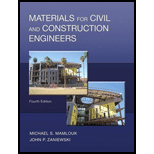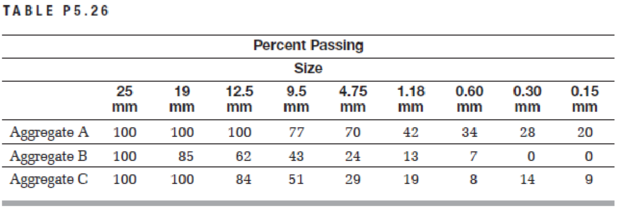
Materials for Civil and Construction Engineers (4th Edition)
4th Edition
ISBN: 9780134320533
Author: Michael S. Mamlouk, John P. Zaniewski
Publisher: PEARSON
expand_more
expand_more
format_list_bulleted
Textbook Question
Chapter 5, Problem 5.26QP
Table P5.26 shows the grain size distributions of aggregates A, B, and C. The three aggregates must be blended at a ratio of 15:25:60 by weight, respectively. Using a spreadsheet program, determine the grain size distribution of the blend.

Expert Solution & Answer
Want to see the full answer?
Check out a sample textbook solution
Students have asked these similar questions
STRUCTURES I
Homework #1: Force Systems
Name:
TA:
PROBLEM 1
Determine the horizontal and vertical components of
the force in the cable shown.
PROBLEM 2
The horizontal component of force F is 30 lb. What is the
magnitude of force F?
6
10
4
4
F = 600lbs
F = ?
18:02
28%
50
同
こ
【Recommend】 Easily add text in PDF
3 m
35 kN
4m
84 kN
+3m
EA = constant
E = 200 GPa
A
T5
4m
Add
1,200 mm²
Find Horizontal and vertical displacement at B
4 kN
m
m-
B
Determine Vertical displacement at C
Determine the displacement or point B of the steel beam shown in
Take E200 GPa, I = 500(106) mm4.
5 m 2/
40 kN
B
12 kN/m
4 m.
12 kN/m
3 m
B
10 m-
E
constant = 70 GPa
I 554 (10) mm
Determine Displacement at C
ΙΣΤ
Edit
Annotate
Fill & Sign
Convert
All
In a floor of an industrial building, boilers are supported symmetrically on secondary
beams A and B, which have a centre-to-centre distance of 5 m and which are in turn
supported by the main beam, which has a span of 9 m (see Fig. 10.62). Design the
main beam given the following data:
Chapter 5 Solutions
Materials for Civil and Construction Engineers (4th Edition)
Ch. 5 - Prob. 5.1QPCh. 5 - Discuss five different desirable characteristics...Ch. 5 - Discuss five different desirable characteristics...Ch. 5 - The shape and surface texture of aggregate...Ch. 5 - Define the following terms: a. Saturated...Ch. 5 - Three samples of fine aggregate have the...Ch. 5 - A sample of wet aggregate weighed 297.2 N. After...Ch. 5 - 46.5 kg (102.3 lb) of fine aggregate is mixed with...Ch. 5 - Samples of coarse aggregate from a stockpile are...Ch. 5 - Base course aggregate has a target dry density of...
Ch. 5 - Calculate the percent voids between aggregate...Ch. 5 - Calculate the percent voids between aggregate...Ch. 5 - Coarse aggregate is placed in a rigid bucket and...Ch. 5 - The following laboratory tests are performed on...Ch. 5 - Students in the materials lab performed the...Ch. 5 - The specific gravity and absorption test (ASTM...Ch. 5 - Prob. 5.18QPCh. 5 - Calculate the sieve analysis shown in Table P5.19...Ch. 5 - Calculate the sieve analysis shown in Table P5.20,...Ch. 5 - A sieve analysis test was performed on a sample of...Ch. 5 - A sieve analysis test was performed on a sample of...Ch. 5 - Draw a graph to show the cumulative percent...Ch. 5 - Referring to Table 5.6, plot the specification...Ch. 5 - Referring to the aggregate gradations A, B, and C...Ch. 5 - Table P5.26 shows the grain size distributions of...Ch. 5 - Table P5.27 shows the grain size distributions of...Ch. 5 - Three aggregates are to be mixed together in the...Ch. 5 - Table P5.29 shows the grain size distribution for...Ch. 5 - Laboratory specific gravity and absorption tests...Ch. 5 - Table P5.31 shows the grain size distribution for...Ch. 5 - Prob. 5.32QPCh. 5 - Laboratory specific gravity and absorption tests...Ch. 5 - Prob. 5.34QPCh. 5 - Define the fineness modulus of aggregate. What is...Ch. 5 - Calculate the fineness modulus of aggregate A in...Ch. 5 - Calculate the fineness modulus of aggregate B in...Ch. 5 - A portland cement concrete mix requires mixing...Ch. 5 - Discuss the effect of the amount of material...Ch. 5 - Aggregates from three sources having the...Ch. 5 - Aggregates from three sources having the...Ch. 5 - A contractor is considering using three stockpiles...Ch. 5 - Prob. 5.43QPCh. 5 - What are the typical deleterious substances in...Ch. 5 - Review ASTM D75 and summarize the following: a....
Knowledge Booster
Learn more about
Need a deep-dive on the concept behind this application? Look no further. Learn more about this topic, civil-engineering and related others by exploring similar questions and additional content below.Similar questions
- S₂ S S,-40 S,-100 P S,=40 40 80 80 40arrow_forwardThe bolted connection shown is connected with M20 bolts in standard holes. The plate material is A36 steel. Find the allowable (ASD) tensile strength of each plate. 50 65 65 65 13 40 65 40 13arrow_forwardA 3.048 m long column (Fy = 483 MPa) carries an axial compression load of 5000 kN dead load. The column is braced at mid-height to strengthen the column in the weak direction. Use LRFD. Which of the following most nearly gives the nominal compressive strength? Show solution and drawingsarrow_forward
- When an open-ended square tube is placed vertically into a pool of water, the water rises 4 mm up inside of the tube. A) Determine the inner length of the square tube. A solid cylindrical rod is then placed vertically down the center of the open-ended square tube and the water rises an additional 4 mm up the tube. B) Determine the diameter of the solid rod that was inserted. 0.073 @ 20N m T C s = = o .arrow_forwardPlease use the following labels in the image such as Va, Vbr, Vbl and etc. Show step by step solution for each. Thanks!arrow_forwardThe single story building shown in Fig. 2 has an applied uniform load of 300 psf (0.3ksf) including the self weight of the beams and the girders. The roof has a 16 ft x 15 ft opening as shown. 1. Determine the axial loads on Columns C1 and C2 using reactions from the beams supported on the columns. 2. Determine the axial loads on Columns C1 and C2 using the concept of tributary areas.arrow_forward
- A built-up beam section is formed by welding 2xL8x6x1 angles to the bottom flange of W36x210 as shown in Fig. 1. Determine the following section properties of the built-up cross section: a. Cross sectional area, A (in2) b. The location of the centroids CG-X and CG-Y id of the built up section from the bottom of angle ( this value is given, so you need to check that you get this value) c. Moments of inertia ICG-X (in4) and ICG-Y (in4) d. Section modulus Sx (bot) (in3) and Sx (top) (in3) e. Radius of gyration rx (in) and ry (in) f. Weight of the built up section, w (lb/ft) (use density of steel = 490 pcf) g. Surface area of the built-up section, S(ft2/ft)arrow_forward11. Design the main beam of a building supporting concrete floor slab as shown in Fig. 10.61 and with the following data: (i) Beam centres: 6 m (ii) Span (simply supported): 7.4 m (iii) Concrete slab (spanning in two directions): 240-mm thick (iv) Finished screed: 40-mm thick (v) Imposed load: 4 kN/m² (vi) Take weight of concrete slab as 24 kN/m³ and total weight of 40-mm thick screed as 1.0 kN/m² Assume Fe 410 grade steel and take initial weight of beam as 1.0 kN/m. H H- Main beam 7.4 m 6.0 m H 40 mm screed I -H. Fig. 10.61 k 240 mm slab 6.0 m Typical bay of large floor areaarrow_forwardConsider the situation in Question 2. If all the cables are made of the same material and have a maximum tensile force of 500 lb, what is the heaviest load that can be supported by the system?arrow_forward
- A flexible circular area is subjected to a uniformly distributed load of 148 (see the figure below). The diameter of the load area is 2 . Estimate the average stress increase () below the center of the loaded area between depths of 3 and 6 . Use the equations: and (Enter your answer to three significant figures.) =arrow_forwardA square flexible foundation of width B applies a uniform pressure go to the underlying ground. (a) Determine the vertical stress increase at a depth of 0.625B below the center using Aσ beneath the corner of a uniform rectangular load given by Aσ = Variation of Influence Value I qoI. Use the table below. n 0.8 1.0 m 0.2 0.4 0.5 0.6 0.2 0.01790 0.03280 0.03866 0.04348 0.05042 0.05471 0.4 0.03280 0.06024 0.07111 0.08009 0.09314 0.10129 0.5 0.03866 0.07111 0.08403 0.09473 0.11035 0.12018 0.6 0.04348 0.08009 0.09473 0.10688 0.12474 0.13605 0.8 0.05042 0.09314 0.11035 0.12474 0.14607 0.15978 1.0 0.05471 0.10129 0.12018 0.13605 0.15978 0.17522 (Enter your answer to three significant figures.) Ασ/90 = (b) Determine the vertical stress increase at a depth of 0.625B below the center using the 2 : 1 method equation below. 90 x B x L Aσ = (B+ z) (L + z) (Enter your answer to three significant figures.) Ασ/90 = (c) Determine the vertical stress increase at a depth of 0.625B below the center using…arrow_forwardPoint loads of magnitude 100, 200, and 360 act at , , and , respectively (in the figure below). Determine the increase in vertical stress at a depth of 6 below point . Use Boussinesq's equation. (Enter your answer to three significant figures.) =arrow_forward
arrow_back_ios
SEE MORE QUESTIONS
arrow_forward_ios
Recommended textbooks for you
 Solid Waste EngineeringCivil EngineeringISBN:9781305635203Author:Worrell, William A.Publisher:Cengage Learning,
Solid Waste EngineeringCivil EngineeringISBN:9781305635203Author:Worrell, William A.Publisher:Cengage Learning, Traffic and Highway EngineeringCivil EngineeringISBN:9781305156241Author:Garber, Nicholas J.Publisher:Cengage Learning
Traffic and Highway EngineeringCivil EngineeringISBN:9781305156241Author:Garber, Nicholas J.Publisher:Cengage Learning Fundamentals of Geotechnical Engineering (MindTap...Civil EngineeringISBN:9781305635180Author:Braja M. Das, Nagaratnam SivakuganPublisher:Cengage Learning
Fundamentals of Geotechnical Engineering (MindTap...Civil EngineeringISBN:9781305635180Author:Braja M. Das, Nagaratnam SivakuganPublisher:Cengage Learning Construction Materials, Methods and Techniques (M...Civil EngineeringISBN:9781305086272Author:William P. Spence, Eva KultermannPublisher:Cengage Learning
Construction Materials, Methods and Techniques (M...Civil EngineeringISBN:9781305086272Author:William P. Spence, Eva KultermannPublisher:Cengage Learning Materials Science And Engineering PropertiesCivil EngineeringISBN:9781111988609Author:Charles GilmorePublisher:Cengage Learning
Materials Science And Engineering PropertiesCivil EngineeringISBN:9781111988609Author:Charles GilmorePublisher:Cengage Learning Engineering Fundamentals: An Introduction to Engi...Civil EngineeringISBN:9781305084766Author:Saeed MoaveniPublisher:Cengage Learning
Engineering Fundamentals: An Introduction to Engi...Civil EngineeringISBN:9781305084766Author:Saeed MoaveniPublisher:Cengage Learning

Solid Waste Engineering
Civil Engineering
ISBN:9781305635203
Author:Worrell, William A.
Publisher:Cengage Learning,

Traffic and Highway Engineering
Civil Engineering
ISBN:9781305156241
Author:Garber, Nicholas J.
Publisher:Cengage Learning

Fundamentals of Geotechnical Engineering (MindTap...
Civil Engineering
ISBN:9781305635180
Author:Braja M. Das, Nagaratnam Sivakugan
Publisher:Cengage Learning

Construction Materials, Methods and Techniques (M...
Civil Engineering
ISBN:9781305086272
Author:William P. Spence, Eva Kultermann
Publisher:Cengage Learning

Materials Science And Engineering Properties
Civil Engineering
ISBN:9781111988609
Author:Charles Gilmore
Publisher:Cengage Learning

Engineering Fundamentals: An Introduction to Engi...
Civil Engineering
ISBN:9781305084766
Author:Saeed Moaveni
Publisher:Cengage Learning
Aggregates: Properties; Author: nptelhrd;https://www.youtube.com/watch?v=49yGZYeokKM;License: Standard YouTube License, CC-BY